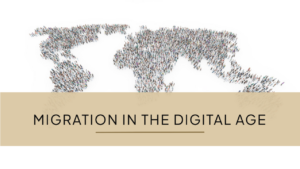
Lately, I’ve found myself navigating through various ideas, often pulled in new directions as the field of education reveals its vastness and complexity. It can be a real challenge to focus on just one pressing issue, especially when education is so deeply intertwined with societal systems and global challenges.
One consistent anchor for me has been the intersection of migration, forced displacement, and education. Before joining my graduate program in Education Futures, I was already interested in how migration affects learning. But my understanding has since deepened, especially as I’ve explored concepts like lifelong learning, the role of technology, and the importance of cultural heritage. These new perspectives are shaping a more holistic approach to education for displaced communities.
Lifelong learning has become a key focus in my exploration. For refugees and migrants, education is often disrupted, making traditional schooling models insufficient. Lifelong learning, however, offers a flexible framework that supports continuous education regardless of location or life stage. It’s a way to adapt to the challenges of displacement, ensuring that learning doesn’t stop when formal schooling is interrupted. In fact, lifelong learning can serve as both a lifeline and a strategy for navigating the unpredictable realities of migration (Unesco Institute for Lifelong Learning, 2020).
Technology, particularly mobile and digital platforms, has also emerged as a critical tool in this space. Mobile devices, for example, have become vital for displaced individuals, offering access to essential services, enabling connection with loved ones, and supporting educational efforts. However, the reality is more complex. Barriers such as digital literacy, connectivity issues, and unequal access limit the potential of these tools (GSMA, 2022). The pandemic accelerated this digital shift, highlighting how essential connectivity and digital inclusion are, particularly for displaced communities. As we consider solutions, we must ensure that technology is accessible and empowering rather than deepening divides.
Recently, modules on my programme, such as culture, heritage, and learning futures, have introduced me to the idea of “thinking with heritage.” This concept, as highlighted by Richard Sandford, suggests that heritage is more than just a preservation of the past; it offers a way to build more inclusive and connected futures. For displaced people, cultural heritage can serve as a powerful source of identity and continuity, grounding them in their past while enabling them to move forward. Integrating heritage into education not only helps maintain cultural identity but also enriches the learning experience, offering displaced individuals a sense of belonging amid uncertainty (Sandford, 2019).
These intersecting themes—migration, lifelong learning, digital technology, and heritage—are shaping the questions I’m currently exploring:
- How can lifelong learning principles create resilient and adaptable education systems for displaced populations?
- What role can mobile technology play in supporting the educational, social, and cultural needs of migrants and refugees?
- How can we better integrate cultural heritage into education to support the identity and future aspirations of displaced individuals?
- How can educators and policymakers ensure that digital education remains inclusive and safe, particularly against the risks of misinformation and digital exclusion?
Reflecting on these questions, I realise that my journey is less about finding definitive solutions and more about continuously layering new insights, asking better questions, and seeking meaningful connections between these elements. The future of education lies in its ability to adapt and evolve in response to the needs of all learners, especially those whose educational journeys have been disrupted by displacement. It’s through this adaptability that we can help ensure no one is left behind, no matter where they come from or what challenges they face.
References:
GSMA. (2022). The Digital Worlds of Displacement-Affected Communities A cross-context study of how people affected by displacement use mobile phones. https://www.gsma.com/solutions-and-impact/connectivity-for-good/mobile-for-development/wp-content/uploads/2022/10/DigitalWorldsDAC_R2_WEB.pdf
Sandford, R. (2019). Thinking with heritage: Past and present in lived futures. Futures, 111, 71–80. https://doi.org/10.1016/j.futures.2019.06.004
Unesco Institute For Lifelong Learning. (2020). Embracing a culture of lifelong learning contribution to the futures of education initiative : report : a transdisciplinary expert consultation. Hamburg Unesco Institute For Lifelong Learning.

